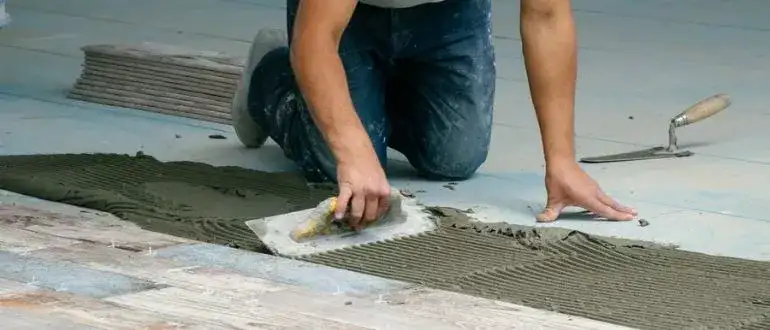Laying 6×24 tile and stumped about the correct trowel size? You’re not alone.
In this guide, get ready to dive deep into the ins and outs of choosing the right tool for your tiling project. Ensure flawless application and a smooth finish every time.
What Size Trowel For 6×24 Tile?
For a 6×24 tile, a 1/2″ x 1/2″ square-notched trowel is typically recommended, ensuring adequate adhesive coverage to account for variations in tile thickness and the substrate, leading to a secure and successful tile installation.
Trowel Size Chart for 6×24 Tile:
| Tile Type | Adhesive Type | Trowel Size |
|---|---|---|
| Ceramic or Porcelain | Thinset Mortar | 1/4″ x 3/8″ Square-Notch or U-Notch |
| Natural Stone | Medium-Bed Mortar | 1/2″ x 1/2″ Square-Notch or U-Notch |
| Glass or Metal | Glass Tile Adhesive | 3/16″ x 5/32″ V-Notch |

What are Notched Trowels?
There are different types of notched trowels. They are:
Square-Notch Trowels
Square-notch trowels have rectangular notches that are evenly spaced and sized.
They are good for applying thinset mortar or medium-bed mortar for ceramic, porcelain, or natural stone tiles.
They can also be used for large-format tiles (tiles that are larger than 15 inches on any side), as they provide more coverage and support for the tiles.
U-Notch Trowels
U-notch trowels have U-shaped notches that are curved at the bottom.
They are similar to square-notch trowels, but they apply less adhesive and create less resistance when spreading it.
They are also good for thinset mortar or medium-bed mortar for ceramic, porcelain, or natural stone tiles.
V-Notch Trowels
V-notch trowels have V-shaped notches that are pointed at the bottom.
They are good for applying glass tile adhesive or mastic (a sticky adhesive) for glass or metal tiles.
They apply less adhesive than square-notch or U-notch trowels, which is important for glass or metal tiles that are transparent or reflective.
Too much adhesive can show through these tiles and ruin their appearance.
>> What kind of trowel for 6×36 tile?
What are Margin Trowels and Pointing Trowels?
Two other types of trowels that are useful for tile installation are margin trowels and pointing trowels.
Margin Trowels
Margin trowels are small and flat trowels that have no notches on their blades.
They are used for mixing adhesive or mortar in small batches, scooping adhesive from buckets or containers, applying adhesive in tight spaces or corners, and smoothing out any excess adhesive.
Pointing Trowels
Pointing trowels are narrow and pointed trowels that have no notches on their blades.
They are used for applying grout (a paste that fills the gaps between tiles) in thin or narrow joints, shaping or smoothing grout lines, and removing any excess grout.
>> What type of trowel for 12×24 floor tile?
How to Select the Appropriate Trowel for 6×24 Tile?
Tile Type and Size
Tile type and size are crucial factors. Different tiles have varied characteristics. These affect the amount of adhesive needed.
Natural stone tiles are heavier and thicker. They need more adhesive and a larger trowel. Glass or metal tiles are smoother.
They need less adhesive and a smaller trowel. Variations in size among tiles should also be considered.
Tile Installation Area
The installation area matters too. Floors require more adhesive and a larger trowel. Walls need a smaller trowel to prevent tile sagging.
The installation area’s shape and size also affect the adhesive application. A margin trowel may be needed for tight spaces or corners.
Tile Thickness
Tile thickness is another key factor. Thicker tiles need deeper notches and more adhesive. Consider the substrate thickness too.
The space between the tile and substrate is crucial. Adjust the adhesive amount and trowel size accordingly.
Adhesive Type
Consider the type of adhesive. Different adhesives have unique properties. Thinset mortar is suitable for thicker tiles and requires a larger trowel.
Glass tile adhesive is ready to use and needs a smaller trowel. Adhesive color matters. Choose a color that complements the tile color.
Substrate Conditions
Examine the condition of the substrate. It can be made of various materials like concrete or plywood. Defects or damages in the substrate affect bonding.
Clean, repair, or prime the substrate if needed. Choose a compatible adhesive. Check for substrate defects before tiling.
Personal Preference and Experience
Lastly, personal preference and experience play a role. Some may prefer a larger trowel for more coverage. Others might want a smaller one for more control.
Try different trowels to find the one that suits you best. Practice on a small area before starting.
>> What size trowel for mosaic tile installation?
Importance of Using the Correct Trowel Size
Here are some of the benefits of using the correct trowel size:
Consistency in Tile Installation
Using the correct trowel size ensures that you apply a consistent amount of adhesive across the installation area.
This helps you avoid gaps or voids under the tiles, which can cause them to crack or break over time.
It also helps you avoid excess or uneven adhesive on top of the tiles, which can make them look messy or uneven.
Adequate Adhesive Coverage
Using the correct trowel size ensures that you achieve adequate adhesive coverage on both the tile and the substrate.
This means that at least 80% of the surface area of both the tile and the substrate should be covered with adhesive when you set the tile.
Adequate adhesive coverage ensures a strong bond between the tile and the substrate, which prevents them from separating or shifting over time.
Avoiding Lippage
Using the correct trowel size ensures that you apply an appropriate thickness of adhesive under the tiles.
This helps you avoid lippage, which is when some tiles are higher or lower than others. Lippage can make your tile installation look uneven and unprofessional.
It can also create tripping hazards or damage your tiles.
Longevity of Tile Installation
Using the correct trowel size ensures that you protect your tiles from moisture, temperature changes, and other external factors that can affect their performance and appearance over time.
The adhesive acts as a barrier that prevents water from seeping under the tiles, which can cause mold growth or tile deterioration.
The adhesive also acts as a cushion that absorbs shock and stress from foot traffic or weight, which can cause tile cracking or chipping.
How to Use a Trowel for Tile Installation?
Spreading the Adhesive
Start by mixing your adhesive. Follow the instructions on the pack. The mix should be smooth and lump-free. Next, scoop some adhesive with your trowel.
Place it on the substrate in a small area. It should cover 2-3 square feet. Keep your trowel at a 45-degree angle. Spread the adhesive evenly. Use firm pressure.
Then, use the notched side of your trowel. Comb through the adhesive in one direction. This action creates ridges in the adhesive.
These ridges let air escape when you set the tile. Work in small sections and apply fresh adhesive as needed. The adhesive should not dry before setting the tile.
Achieving the Right Adhesive Thickness
Consider the size of the notches on your trowel. Also, consider the thickness of your tile. The notches should be half the thickness of your tile.
For example, for a 1/4 inch thick, 6×24 tile, use a trowel with 1/8 inch deep notches. This results in a 1/4 inch thick adhesive layer. Do a test by setting a tile and lifting it.
You should see adhesive covering at least 80% of the tile’s back. If you see less, use a larger trowel or apply more pressure.
If you see more, use a smaller trowel or apply less pressure.
>> What notched trowel size for wall tiles?
Setting the Tile
Now, start setting the tile. Place the tile on the adhesive. Press it firmly with a slight twist. This action makes the tile stick well and removes air pockets.
Align the tile with your layout lines. Keep enough space between tiles for the grout. Use spacers or wedges to keep consistent spacing.
Wipe off any excess adhesive immediately. Use a damp sponge or cloth. Continue this process until you set all tiles in your area.
Cleaning Excess Adhesive
Finally, clean any excess adhesive from the joints and edges. Use a margin trowel or a pointing trowel to scrape off excess adhesive.
You can also use a utility knife or razor blade to remove adhesive from edges. Clean excess adhesive before it dries. It is harder to remove when dry.
Avoid contact with skin or eyes to prevent irritation or injury.
>> What size trowel for 3×6 ceramic tile?
FAQs About Right Size Trowel For 6×24 Tile
Is 6×24 Tile A Large Format?
Generally, rectangular or square shape tiles with over 12 X 12 are considered larger tile formats.
What size grout joints should I leave on 6×24 tiles?
1/8 inch grout joints are recommended with 6×24 tile. Adjust thinset ridges and tile spacing accordingly.
Is It Ok To Lay Hardwood Over 6 X 24 Tile?
Of course, 6 X 24 is a decent shape of tile that allows hardwood or laminating flooring over it. However, you can’t install ¾ ” hardwood flooring over the tile.
Can I use premixed thinset mortar with 6×24 tiles?
Premixed thinset has less strength. Use a polymer modified dry-set mortar meeting ANSI A118.4 standards.
Final words
Armed with the right trowel size, you’re ready to tackle your 6×24 tile project. Remember, a proper tool makes all the difference in tile installation.
It ensures an even, smooth finish, making your space look professional and polished. So, choose wisely, and watch your space transform beautifully before your eyes.
Your journey to perfect tiling starts here!

